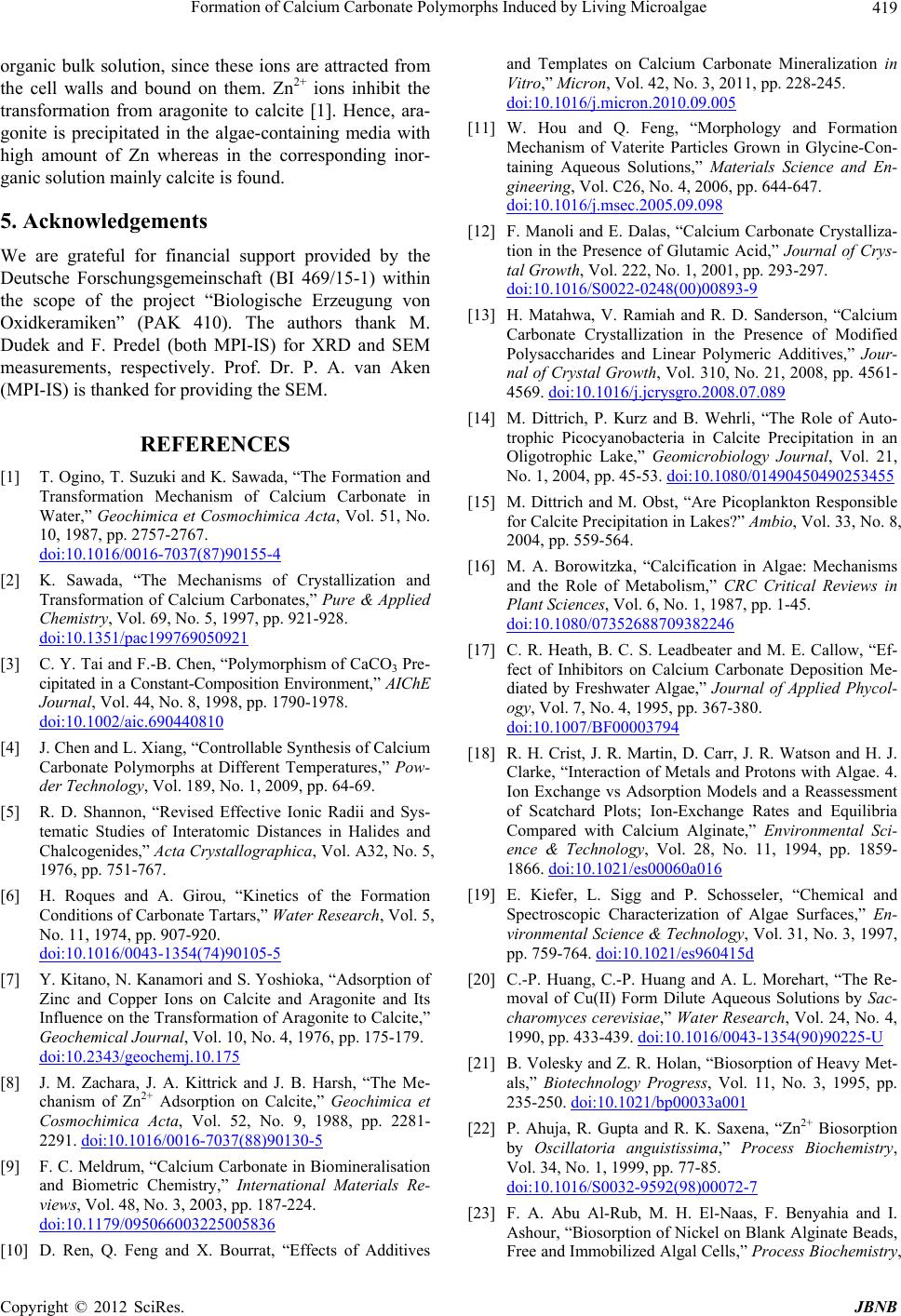
Formation of Calcium Carbonate Polymorphs Induced by Living Microalgae 419
organic bulk solution, since these ions are attracted from
the cell walls and bound on them. Zn2+ ions inhibit the
transformation from aragonite to calcite [1]. Hence, ara-
gonite is precipitated in the algae-containing media with
high amount of Zn whereas in the corresponding inor-
ganic solution mainly calcite is found.
5. Acknowledgements
We are grateful for financial support provided by the
Deutsche Forschungsgemeinschaft (BI 469/15-1) within
the scope of the project “Biologische Erzeugung von
Oxidkeramiken” (PAK 410). The authors thank M.
Dudek and F. Predel (both MPI-IS) for XRD and SEM
measurements, respectively. Prof. Dr. P. A. van Aken
(MPI-IS) is thanked for providing the SEM.
REFERENCES
[1] T. Ogino, T. Suzuki and K. Sawada, “The Formation and
Transformation Mechanism of Calcium Carbonate in
Water,” Geochimica et Cosmochimica Acta, Vol. 51, No.
10, 1987, pp. 2757-2767.
doi:10.1016/0016-7037(87)90155-4
[2] K. Sawada, “The Mechanisms of Crystallization and
Transformation of Calcium Carbonates,” Pure & Applied
Chemistry, Vol. 69, No. 5, 1997, pp. 921-928.
doi:10.1351/pac199769050921
[3] C. Y. Tai and F.-B. Chen, “Polymorphism of CaCO3 Pre-
cipitated in a Constant-Composition Environment,” AIChE
Journal, Vol. 44, No. 8, 1998, pp. 1790-1978.
doi:10.1002/aic.690440810
[4] J. Chen and L. Xiang, “Controllable Synthesis of Calcium
Carbonate Polymorphs at Different Temperatures,” Pow-
der Technology, Vol. 189, No. 1, 2009, pp. 64-69.
[5] R. D. Shannon, “Revised Effective Ionic Radii and Sys-
tematic Studies of Interatomic Distances in Halides and
Chalcogenides,” Acta Crystallographica, Vol. A32, No. 5,
1976, pp. 751-767.
[6] H. Roques and A. Girou, “Kinetics of the Formation
Conditions of Carbonate Tartars,” Water Research, Vol. 5,
No. 11, 1974, pp. 907-920.
doi:10.1016/0043-1354(74)90105-5
[7] Y. Kitano, N. Kanamori and S. Yoshioka, “Adsorption of
Zinc and Copper Ions on Calcite and Aragonite and Its
Influence on the Transformation of Aragonite to Calcite,”
Geochemical Journal, Vol. 10, No. 4, 1976, pp. 175-179.
doi:10.2343/geochemj.10.175
[8] J. M. Zachara, J. A. Kittrick and J. B. Harsh, “The Me-
chanism of Zn2+ Adsorption on Calcite,” Geochimica et
Cosmochimica Acta, Vol. 52, No. 9, 1988, pp. 2281-
2291. doi:10.1016/0016-7037(88)90130-5
[9] F. C. Meldrum, “Calcium Carbonate in Biomineralisation
and Biometric Chemistry,” International Materials Re-
views, Vol. 48, No. 3, 2003, pp. 187-224.
doi:10.1179/095066003225005836
[10] D. Ren, Q. Feng and X. Bourrat, “Effects of Additives
and Templates on Calcium Carbonate Mineralization in
Vitro,” Micron, Vol. 42, No. 3, 2011, pp. 228-245.
doi:10.1016/j.micron.2010.09.005
[11] W. Hou and Q. Feng, “Morphology and Formation
Mechanism of Vaterite Particles Grown in Glycine-Con-
taining Aqueous Solutions,” Materials Science and En-
gineering, Vol. C26, No. 4, 2006, pp. 644-647.
doi:10.1016/j.msec.2005.09.098
[12] F. Manoli and E. Dalas, “Calcium Carbonate Crystalliza-
tion in the Presence of Glutamic Acid,” Journal of Crys-
tal Growth, Vol. 222, No. 1, 2001, pp. 293-297.
doi:10.1016/S0022-0248(00)00893-9
[13] H. Matahwa, V. Ramiah and R. D. Sanderson, “Calcium
Carbonate Crystallization in the Presence of Modified
Polysaccharides and Linear Polymeric Additives,” Jour-
nal of Crystal Growth, Vol. 310, No. 21, 2008, pp. 4561-
4569. doi:10.1016/j.jcrysgro.2008.07.089
[14] M. Dittrich, P. Kurz and B. Wehrli, “The Role of Auto-
trophic Picocyanobacteria in Calcite Precipitation in an
Oligotrophic Lake,” Geomicrobiology Journal, Vol. 21,
No. 1, 2004, pp. 45-53. doi:10.1080/01490450490253455
[15] M. Dittrich and M. Obst, “Are Picoplankton Responsible
for Calcite Precipitation in Lakes?” Ambio, Vol. 33, No. 8,
2004, pp. 559-564.
[16] M. A. Borowitzka, “Calcification in Algae: Mechanisms
and the Role of Metabolism,” CRC Critical Reviews in
Plant Sciences, Vol. 6, No. 1, 1987, pp. 1-45.
doi:10.1080/07352688709382246
[17] C. R. Heath, B. C. S. Leadbeater and M. E. Callow, “Ef-
fect of Inhibitors on Calcium Carbonate Deposition Me-
diated by Freshwater Algae,” Journal of Applied Phycol-
ogy, Vol. 7, No. 4, 1995, pp. 367-380.
doi:10.1007/BF00003794
[18] R. H. Crist, J. R. Martin, D. Carr, J. R. Watson and H. J.
Clarke, “Interaction of Metals and Protons with Algae. 4.
Ion Exchange vs Adsorption Models and a Reassessment
of Scatchard Plots; Ion-Exchange Rates and Equilibria
Compared with Calcium Alginate,” Environmental Sci-
ence & Technology, Vol. 28, No. 11, 1994, pp. 1859-
1866. doi:10.1021/es00060a016
[19] E. Kiefer, L. Sigg and P. Schosseler, “Chemical and
Spectroscopic Characterization of Algae Surfaces,” En-
vironmental Science & Technology, Vol. 31, No. 3, 1997,
pp. 759-764. doi:10.1021/es960415d
[20] C.-P. Huang, C.-P. Huang and A. L. Morehart, “The Re-
moval of Cu(II) Form Dilute Aqueous Solutions by Sac-
charomyces cerevisiae,” Water Research, Vol. 24, No. 4,
1990, pp. 433-439. doi:10.1016/0043-1354(90)90225-U
[21] B. Volesky and Z. R. Holan, “Biosorption of Heavy Met-
als,” Biotechnology Progress, Vol. 11, No. 3, 1995, pp.
235-250. doi:10.1021/bp00033a001
[22] P. Ahuja, R. Gupta and R. K. Saxena, “Zn2+ Biosorption
by Oscillatoria anguistissima,” Process Biochemistry,
Vol. 34, No. 1, 1999, pp. 77-85.
doi:10.1016/S0032-9592(98)00072-7
[23] F. A. Abu Al-Rub, M. H. El-Naas, F. Benyahia and I.
Ashour, “Biosorption of Nickel on Blank Alginate Beads,
Free and Immobilized Algal Cells,” Process Biochemistry,
Copyright © 2012 SciRes. JBNB